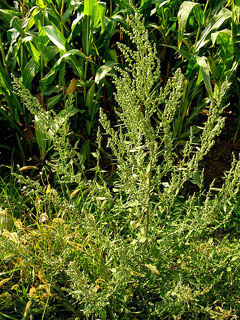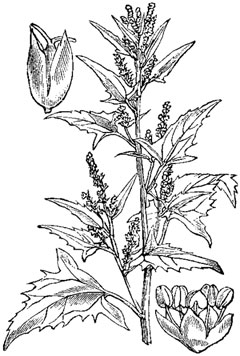 |
|
http://commons.wikimedia.org/wiki/File:UitstaandeMeldeSorinnesDSCN4516.JPG |
 |
|
Translate this page:
Summary
Native desert shrub; very poor food—leaves and seeds both harsh.
Physical Characteristics

 Atriplex patula is a ANNUAL growing to 0.8 m (2ft 7in). It is in flower from July to September, and the seeds ripen from August to October. The species is monoecious (individual flowers are either male or female, but both sexes can be found on the same plant) and is pollinated by Wind, insects. The plant is self-fertile.
Atriplex patula is a ANNUAL growing to 0.8 m (2ft 7in). It is in flower from July to September, and the seeds ripen from August to October. The species is monoecious (individual flowers are either male or female, but both sexes can be found on the same plant) and is pollinated by Wind, insects. The plant is self-fertile.
Suitable for: light (sandy) and medium (loamy) soils, prefers well-drained soil and can grow in heavy clay soil. Suitable pH: mildly acid, neutral and basic (mildly alkaline) soils and can grow in very alkaline and saline soils.
It cannot grow in the shade. It prefers moist soil.
UK Hardiness Map
US Hardiness Map
Synonyms
Plant Habitats
Cultivated Beds;
Edible Uses
Edible Parts: Leaves Seed
Edible Uses:
Edible uses & rating: Leaves historically boiled (Hopi), seeds used in scarcity years. Edibility rating: 1/5. Taste & processing notes: Leaves intensely acrid; require multiple water changes; foam persists; flavor remains poor. Seeds are salty/woody/acrid. Season/harvest: Desert; summer bloom, autumn seed [2-3]. Young leaves - raw or cooked as a spinach substitute[5, 85, 95, 153, 183]. A fairly bland flavour, a few leaves of stronger-flavoured plants can be added to enhance the taste[9]. Seed - ground and mixed with cornmeal or used to thicken soups etc[183]. Small and very fiddly to harvest and use[9].
References More on Edible Uses
Medicinal Uses
Plants For A Future can not take any responsibility for any adverse effects from the use of plants. Always seek advice from a professional before using a plant medicinally.
Laxative
The seeds, harvested when just ripe, are said to be as efficacious as ipecacuanha as a laxative[4].
References More on Medicinal Uses
The Bookshop: Edible Plant Books
Our Latest books on Perennial Plants For Food Forests and Permaculture Gardens in paperback or digital formats.

Edible Tropical Plants
Food Forest Plants for Hotter Conditions: 250+ Plants For Tropical Food Forests & Permaculture Gardens.
More

Edible Temperate Plants
Plants for Your Food Forest: 500 Plants for Temperate Food Forests & Permaculture Gardens.
More

More Books
PFAF have eight books available in paperback and digital formats. Browse the shop for more information.
Shop Now
Other Uses
Excellent nurse/hedge in severe deserts; minimal water. Wildlife/ecology: Browse (limited); cover; salinity tolerance for restoration.
Special Uses
References More on Other Uses
Cultivation details
Full sun; hyper-arid alkaline basins. Succeeds in full sun in any well-drained but not too fertile soil[200]. Prefers a rich soil. Tolerates saline and very alkaline soils[200]. Habitat & range: Sonoran/Mojave deserts.
References Carbon Farming Information and Carbon Sequestration Information
Temperature Converter
Type a value in the Celsius field to convert the value to Fahrenheit:
Fahrenheit:
The PFAF Bookshop
Plants For A Future have a number of books available in paperback and digital form. Book titles include Edible Plants, Edible Perennials, Edible Trees,Edible Shrubs, Woodland Gardening, and Temperate Food Forest Plants. Our new book is Food Forest Plants For Hotter Conditions (Tropical and Sub-Tropical).
Shop Now
Plant Propagation
Seed - sow April/May in situ[134]. Germination is usually rapid. Cuttings possible.
Other Names
If available other names are mentioned here
Native Range
TEMPERATE ASIA: Afghanistan, Cyprus, Iran, Lebanon, Syria, Turkey, Russian Federation-Ciscaucasia (Ciscaucasia), Armenia, Azerbaijan, Georgia, Russian Federation (Dagestan), Russian Federation-Western Siberia (Western Siberia), Russian Federation-Eastern Siberia (Eastern Siberia), Russian Federation (Altay), Kazakhstan (rare), Uzbekistan, China (Xinjiang Uygur Zizhiqu (west)) EUROPE: Denmark, Finland, United Kingdom, Ireland, Norway, Sweden, Austria, Belgium, Switzerland, Czech Republic, Germany, Hungary, Netherlands, Poland, Slovakia, Russian Federation (European part), Belarus, Estonia, Lithuania, Latvia, Moldova, Ukraine (incl. Krym), Albania, Bulgaria, Bosnia and Herzegovina, Greece (incl. Crete), Croatia, Italy (incl. Sardinia, Sicily), North Macedonia, Montenegro, Romania, Serbia, Slovenia, Spain (incl. Baleares), France (incl. Corsica), Portugal AFRICA: Algeria, Egypt, Morocco, Tunisia
Weed Potential
Right plant wrong place. We are currently updating this section.
Please note that a plant may be invasive in one area but may not in your area so it's worth checking.
Low
Conservation Status
IUCN Red List of Threatened Plants Status :

| Related Plants
|
| Latin Name | Common Name | Habit | Height | Hardiness | Growth | Soil | Shade | Moisture | Edible | Medicinal | Other |
| Atriplex argentea | Silvery Orach, Silverscale saltbush, Stalked saltbush | Annual | 0.5 |
4-9
| | LM | N | M | 3 | 2 | 2 |
| Atriplex argentea expansa | Silverscale Saltbush | Annual | 0.6 |
-
| | LM | N | M | 2 | 0 | |
| Atriplex californica | California Orach, California saltbush | Perennial | 0.1 |
7-10
| M | LM | N | DM | 3 | 0 | 3 |
| Atriplex canescens | Grey Sage Brush, Fourwing saltbush | Shrub | 1.8 |
3-9
| M | LM | N | DM | 3 | 1 | 3 |
| Atriplex carnosa | Thickleaf Orach | Annual | 0.9 |
-
| | LM | N | DM | 2 | 0 | |
| Atriplex cinerea | Grey Saltbush | Shrub | 2.0 |
9-11
| M | LM | N | DM | 3 | 0 | 3 |
| Atriplex confertifolia | Shadscale, Shadscale saltbush | Shrub | 1.5 |
4-9
| M | LM | N | DM | 3 | 1 | 2 |
| Atriplex coronata | Crownscale | Annual | 0.4 |
-
| | LM | N | DM | 2 | 0 | |
| Atriplex dimorphostegia | | Annual | 0.2 |
-
| | LM | N | DM | 2 | 0 | |
| Atriplex elegans | Wheelscale Saltbush | Annual | 0.2 |
0-0
| | LM | N | DM | 3 | 0 | 1 |
| Atriplex glabriuscula | Scotland orache, Maritime saltbush, Frankton's saltbush, Northeastern saltbush | Annual | 0.3 |
0-0
| | LM | N | DM | 2 | 0 | |
| Atriplex gmelinii | Gmelin's saltbush | Annual | 0.5 |
0-0
| | LM | N | DM | 2 | 0 | |
| Atriplex halimus | Sea Orach, Saltbush | Shrub | 2.0 |
7-10
| M | LM | N | DM | 5 | 1 | 3 |
| Atriplex hastata | Hastate Orach | Annual | 0.8 |
0-0
| | LM | N | DM | 3 | 0 | 2 |
| Atriplex hortensis | Orach, Garden orache | Annual | 1.8 |
5-9
| F | LM | N | M | 4 | 2 | 3 |
| Atriplex lapathifolia | | Annual | 0.9 |
-
| | LM | N | DM | 3 | 0 | |
| Atriplex lentiformis | Quail Bush, Big saltbush, Quailbush, | Shrub | 3.0 |
8-11
| M | LM | N | DM | 2 | 1 | 3 |
| Atriplex littoralis | Grassleaf orache | Biennial | 0.7 |
4-11
| F | LMH | N | DM | 2 | 0 | 0 |
| Atriplex maximowicziana | Maximowicz's saltbush | Perennial | 0.8 |
0-0
| | LM | N | DM | 2 | 0 | |
| Atriplex mucronata | | Annual | 0.4 |
-
| | LMH | N | DM | 2 | 0 | |
| Atriplex nummularia | Giant Saltbush, Bluegreen saltbush | Shrub | 3.5 |
7-10
| M | LM | N | DM | 3 | 2 | 3 |
| Atriplex nuttallii | Nuttall's Saltbush | Shrub | 0.9 |
5-9
| M | LM | N | DM | 4 | 0 | 2 |
| Atriplex obovata | Mound Saltbrush | Shrub | 1.0 |
5-9
| M | LMH | N | DM | 3 | 0 | 3 |
| Atriplex polycarpa | Cattle spinach | Shrub | 1.0 |
8-10
| M | LM | N | DM | 1 | 0 | 4 |
| Atriplex powellii | Powell's Saltweed | Annual | 0.7 |
4-9
| | LM | N | DM | 3 | 0 | 2 |
| Atriplex rosea | Tumbling or redscale saltweed | Annual | 0.6 |
3-10
| F | LM | N | DM | 2 | 2 | 2 |
| Atriplex saccaria | Sack Saltbush | Annual | 0.3 |
5-9
| | LM | N | DM | 3 | 0 | 0 |
| Atriplex semibaccata | Australian Saltbush. Australian saltbush, Creeping saltbush | Shrub | 0.5 |
8-11
| F | LMH | N | DM | 3 | 0 | 3 |
| Atriplex serenana | Bractscale, Davidson's bractscale | Annual | 3.0 |
8-11
| | LM | N | DM | 3 | 0 | 0 |
|
|
Growth: S = slow M = medium F = fast. Soil: L = light (sandy) M = medium H = heavy (clay). pH: A = acid N = neutral B = basic (alkaline). Shade: F = full shade S = semi-shade N = no shade. Moisture: D = dry M = Moist We = wet Wa = water.
Now available:
Food Forest Plants for Mediterranean Conditions
350+ Perennial Plants For Mediterranean and Drier Food Forests and Permaculture Gardens.
[Paperback and eBook]
This is the third in Plants For A Future's series of plant guides for food forests tailored to
specific climate zones. Following volumes on temperate and tropical ecosystems, this book focuses
on species suited to Mediterranean conditions—regions with hot, dry summers and cool, wet winters,
often facing the added challenge of climate change.
Read More
Expert comment
Author
L.
Botanical References
17
Links / References
For a list of references used on this page please go here
Readers comment